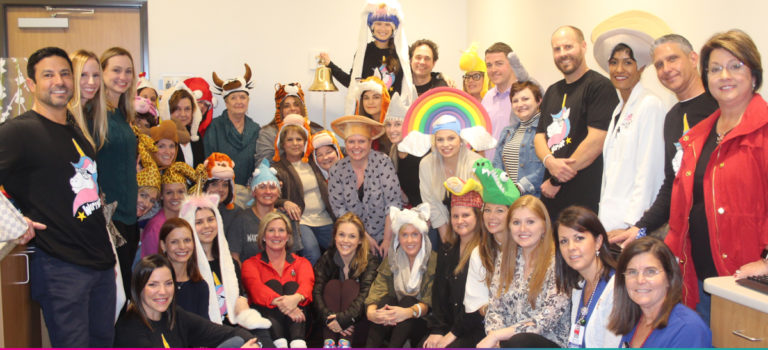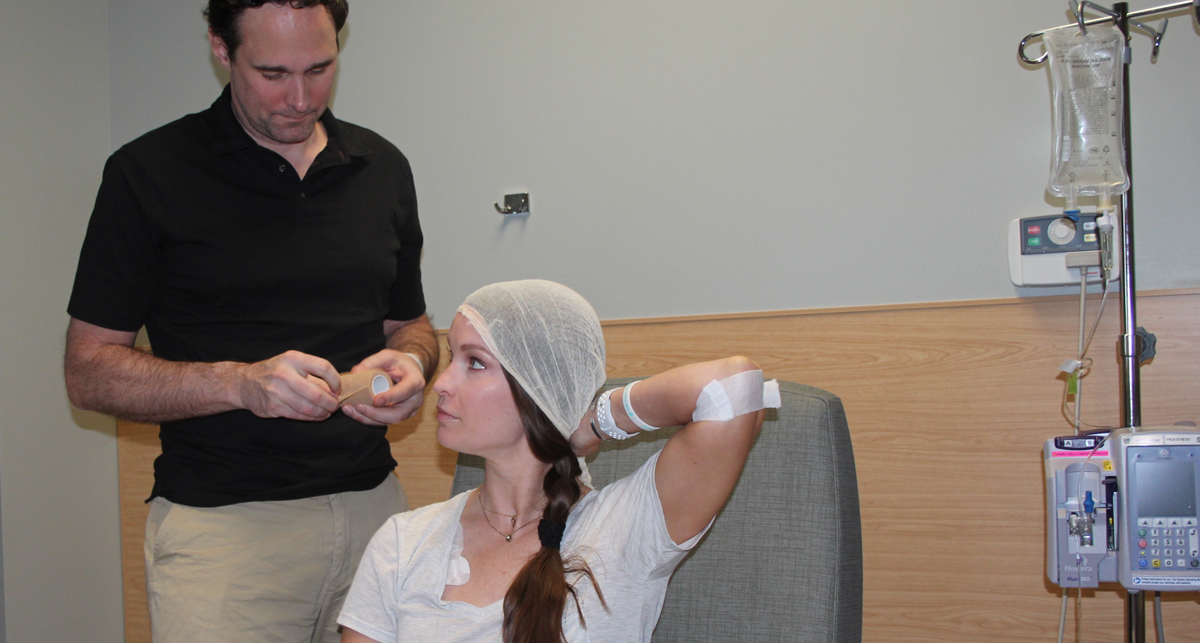When I sit and look in the mirror now, I don’t see a cancer patient. My reflection doesn’t show a woman with a once grim diagnosis, but instead portrays a woman hopeful about the future that lies ahead. And as I study myself and think about my cancer journey, I realize that my choice to do cold cap therapy did so much more than just save my hair; those little blue caps opened my eyes to how much people loved and cared for me, and how that, more than anything, helped me get through some of my darkest days.
I originally chose to do the cold cap therapy as a way to save my hair for my upcoming wedding, which was to take place that fall. But after deciding to get married shortly after starting chemo, I continued to use the cold caps because it provided Mark and me something that we could control. After a cancer diagnosis, there are so many variables and situations that are out of your control, but this was something that was tangible and something we could do to provide us with a small sense of power. It allowed me to control how I saw myself; still having hair helped me to think of myself as “normal” and healthy, providing me a stronger sense of hope. The caps allowed Mark, and so many of my family and friends, to feel in control of something that helped me get better, something they all so badly wanted. Their continued outpouring of love and support has been overwhelming, in the most perfect way, and has made me realize that despite the unfortunate diagnosis, I am truly blessed.
After finishing treatments, the cold caps allowed me to maintain about 70% of my hair. I did lose my eyelashes and eyebrows during chemo; but, I learned how to use a dark eyeliner to draw on brows and mimic a lash line when necessary. Following my double mastectomy, I started losing hair again in a hardcore shedding type way, which I learned was normal, but even still, I was able to keep about 50% of my hair. I’ve recently decided to go for a Kyle Richards-style cut, taking some length off and making it a little lighter. This has helped with maintenance, but also has seemed to put less weight on my roots, allowing it to thrive. And while my hair is coming back curly, it’s a sign of new growth and health, which is a much welcomed blessing. Follow along with me as we retrace the steps, remember the people, and relive the events that have gotten me to where I am today.
Holly’s Sisterhood Story: Cold Cap Crew to the Rescue
I’ve always had nice, long, thick hair. It’s always kind of been “my thing,” something I really liked about myself and often identified myself by. This spring – before my cancer diagnosis – my hair had become something I was focusing a lot on. With all of the wedding planning, I was constantly finding different hairstyles I would consider or want to try. I would spend extra time in the mirror pulling my hair back in different ways, trying to decide if I should wear my hair up or down on the big day. But deciding if an up do was right for me suddenly went away when I was faced with not having any hair at all.
That’s right. No hair. Bald. The idea entered my head the instant that my doctor told me that I needed a biopsy for a lump he found in one of my breasts. I didn’t think of the severity of my potential condition. I didn’t think about what my life might be like after whatever this was. I didn’t think about how this would affect my family or friends. I didn’t think about any of those things. In that moment, my mind raced with the ideas of what a bald bride would look like and if Mark, my fiancé, would still think I was pretty.
I’m not a vain person; I like to think that I define myself based on my morals and actions rather than my looks, but I think any woman will agree that her hair is something that is special to her. Day in and day out, we spend a lot of time fixing it, curling it, straightening it, and often times, obsessing over it. It’s what we twirl around our fingers when we’re nervous, what we flip over our shoulder to flirt, what we pin up when we want to feel beautiful, and what we wash when we need an excuse to get out of something. The idea of not having hair is truly haunting.
I consoled myself by thinking that if this was cancer that they caught it early and I wouldn’t need chemo and my hair would be fine. I had a co-worker that was diagnosed with Stage 1 breast cancer, and you couldn’t even tell. They caught it early and she only needed radiation. Within a few weeks she was “back to normal” and her hair was still very much intact. But on that fateful day in May, I didn’t receive the news I had hoped for, and some of my biggest fears came alive.
I was discussing treatment plans with my oncologist when I confessed my fear of losing my hair. She assured me that I wasn’t alone, that many women have the same thoughts and concerns. She then told me that there were options that could help me retain most of my hair. I was all ears. She told me about cool cap therapy, a type of therapy that uses a cap filled with a cooling agent to cool the scalp and help maintain the hair follicles. Results vary, but most women report retaining up to 70% of their hair. I knew it wasn’t a guarantee, but it was worth a try.
After my first chemo treatment, Mark and I decided that we wanted to get married right away. We didn’t want to wait or put it off any longer. So I was able to be the bride I wished and wanted to be, but in the days after the wedding, I was still worried about losing my hair. I’d find myself lost in a daze thinking about what I would look like and feel like without it. Mark told me that if this was something that was important to me, that we would do what we could to make it happen. As a result, I decided to continue to use the cool caps throughout my remaining fifteen rounds of chemotherapy.
The type of cool cap that I chose requires cycling four caps before, during and after treatments. The whole process starts about an hour before my scheduled treatment with the application of the first cap. Caps are then cycled out every 25 minutes throughout treatment and continue for another four and a half hours at home. We use a cooler with dry ice to keep the caps at the desired -32 degrees Celsius throughout the entire process. The application and cycling of caps requires a trained professional, or in my case, a team of very dedicated family members and friends. Before starting the cool caps, that special group of people went through a series of training sessions to ensure everyone was prepared and ready for the caps to be successful. To help out, my co-worker, Sharon, took the time to create a cool cap schedule and has helped in coordinating the group to make sure I have the help I need. Mark is with me for every treatment and makes sure the caps are cold and stay cold throughout the process. To help make the therapy more bearable, my good friend, Darrell Miller gifted me a variety of animal caps that sit on top of the cooling cap. The animals are fun and make me smile and keep my spirits lifted.
I’ll admit, having something that cold on your head for that long isn’t the most comfortable. After the first time I used the caps, I found myself battling an extreme headache that was a mix between a brain freeze and a wine hangover. There was also a throbbing feeling from having the extremely cold caps on my head for long. But as we’ve moved through the weeks, it’s gotten easier. We learned how to switch the caps out more quickly to maintain a more constant temperature. We learned that a cheese cloth placed on my head helps to reduce the throbbing sensation and pulling of my hair when switching caps.
Because of the commotion the caps can cause, the staff at the Breast and GYN Cancer Pavilion has been more than accommodating and helps coordinate a private room for me and my group. And while they know I have a crew ready to assist, there is always a nurse checking in and asking if there is anything we need. They always make sure everyone is comfortable, asking if we need a warm blanket, a snack, something to drink, etc.
While I am fortunate to be able to say that I’ve retained about 70% of my hair, I will say that cool cap therapy isn’t for the faint of heart. Because the caps work to save the hair follicles, there are limitations to what you can and can’t do with your hair: no ponytails, no messy buns, no curling irons, no straighteners, no tugging and no brushing your hair too hard. As a result, I’ve learned to rock a soft wave or low, loose side braid. Your hair cannot be washed three days before or three days after treatments, which means I can only wash my hair once a week. Washing your hair is also limited to a light washing using only cold water without manipulating the scalp. As a result, my friend Shannon has agreed to wash my hair once a week and my friend Henry got me a heat proof shower cap so I can still enjoy a warm shower from time to time.
Deciding to do cool cap therapy has been one of the best decisions I’ve made. It has helped me retain my hair and continue to feel like myself throughout this journey. It has helped me feel in control of something as I try to navigate through my cancer diagnosis. But more importantly, it has brought me closer to so many special people in my life. Each week I am in awe at the willingness to help and diligence in helping by my cool cap crew. Their outpouring of love and positive vibes helps get me through the long chemo days.
I long for the day to be able to hop in the shower, douse my head in hot water, and throw it up in a top knot to dry. Until then, I’ll continue to take the steps necessary to not only keep my hair, but also beat this cancer. I’ll continue to place a funny, fury friend on top of the cap and remember to smile for all of the blessings I have in my life.
Follow along with Holly’s journey with her personal blog, click here!








